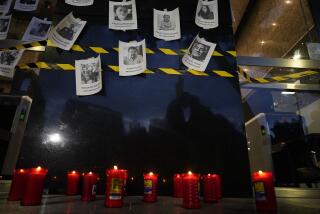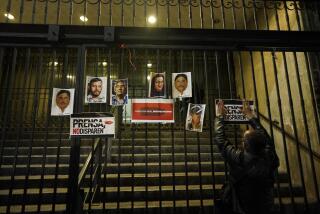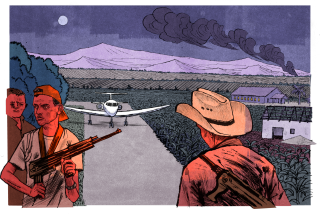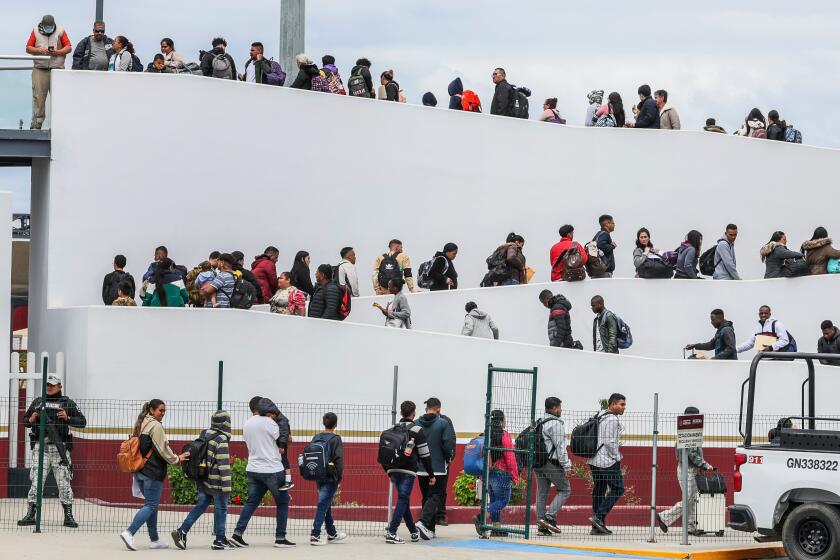‘El Chapo’ is wounded but not caught as Mexico’s military roars into terrified villages
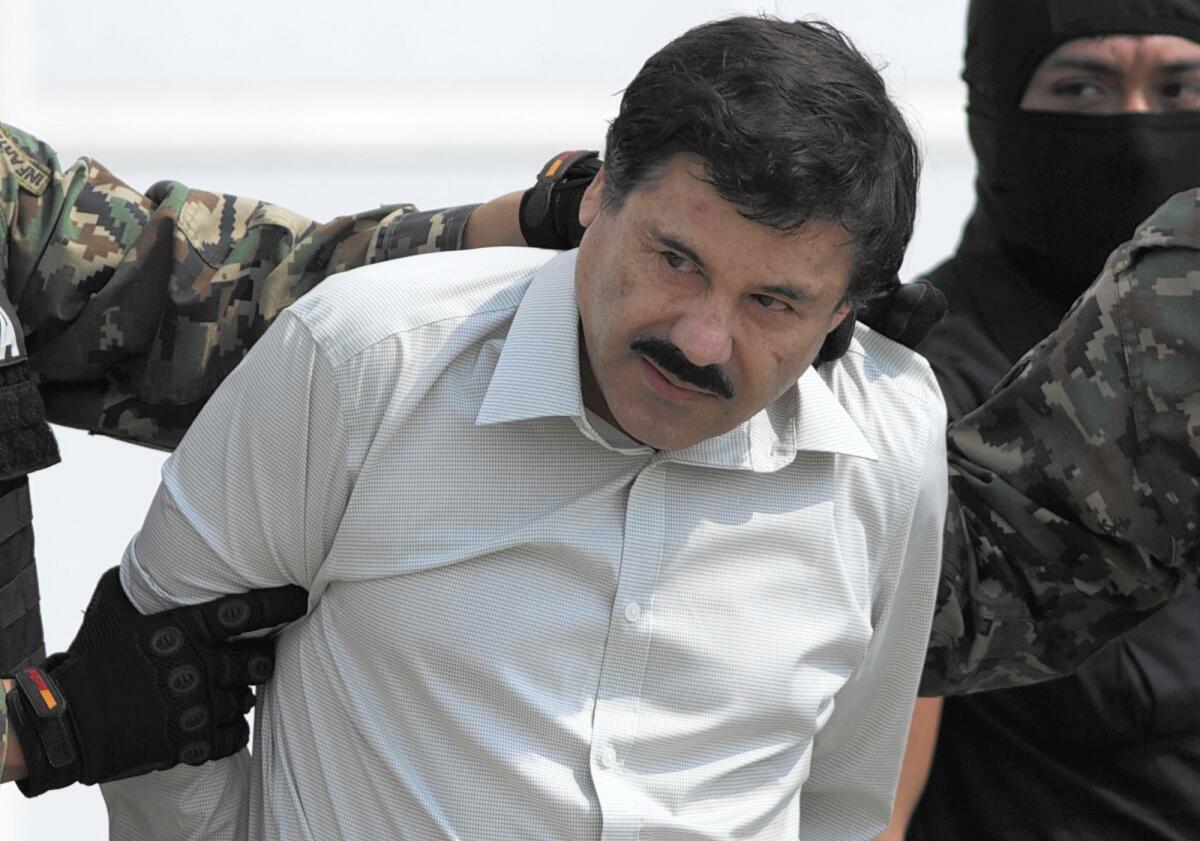
Martha Marbella was getting ready to prepare dinner for her three children one evening last week when a plane flew over their home in the village of El Verano, deep in the Sierra Madre.
Next, three helicopters swooped overhead. The biggest one, dark gray, had the face of a shark painted on it, and the emblem of the Mexican marines. She thought it was preparing to land, but instead it opened fire.
“I was out the back with the baby in my arms when I heard the first bullet hit the house. I just ran and hid behind my back wall,” said Marbella, whose small house was soon peppered with bullet holes.
NEWSLETTER: Get the day’s top headlines from Times Editor Davan Maharaj >>
Her neighbor hid under a bed with her son and his young friends from school.
For more than an hour and a half, “all I could hear was shooting,” said the woman, who was fearful of giving her name.
The massive military operation in El Verano and at least 12 other villages in the rugged borderlands of Durango and Sinaloa was aimed at capturing fugitive cartel leader Joaquin “El Chapo” Guzman, authorities confirmed this week.
“Military personnel from Mexico City are working in the zone,” Sinaloa state Gov. Mario Lopez told reporters. As for Guzman, he said, “Yes, that’s the objective of this group.”
Last week’s major search operation seemed to be focused around the municipality of Tamazula, of which El Verano, La Calera and dozens of other similar villages are a part. Authorities swept in with force after receiving a tip from U.S. Drug Enforcement Administration agents, based on cellphone records, that Guzman was in the area, according to a variety of news reports.
Federal authorities late Friday confirmed that the elusive leader of the Sinaloa cartel had evaded capture, but had been injured while making his escape.
“As part of these efforts and thanks to intelligence and information exchange with international agencies, operations have been carried out across the country,” said a statement from a coalition of federal security agencies. “As a consequence of these actions and to avoid capture, in recent days the fugitive made a hasty escape, which, according to information, caused him injuries in one leg and in the face.”
The military operation last week sent hundreds of people fleeing from their homes, many of them going on foot through the mountains to reach shelter here in Cosala, about 80 miles south.
Guzman was listed by Forbes magazine as Mexico’s 11th-richest man and one of the most powerful people in the world not long before his latest arrest in February 2014. The Sinaloa cartel transports and sells millions of dollars worth of heroin, methamphetamine and marijuana to the United States each year.
But Guzman’s stunning escape in July — through a mile-long tunnel that led from underneath his prison cell — has embarrassed the administration of President Enrique Peña Nieto and sparked a nationwide manhunt whose most recent manifestation is the military operation in the Sierra Madre.
Mexican authorities have said it’s likely that Guzman has returned to the homeland of the Sinaloa cartel in the remote, brush-covered mountains of Mexico’s notorious “Golden Triangle” near where the states of Sinaloa and Durango meet, an impenetrable land dotted with small farming villages such as El Verano.
The area offers hiding places and an often-friendly populace, and is difficult for authorities to enter except by way of heavily armed operations of the kind mounted by the marines last week.
This month, Atty. Gen. Arely Gomez Gonzalez announced the detention of the pilot who authorities claim flew Guzman away after his prison break. The pilot, who wasn’t named, is suspected of lifting Guzman from a partially constructed house in which he surfaced from the ventilated tunnel leading from his cell in the Altiplano prison.
Additional leads have come from records extracted from cellphones belonging to Guzman’s attorneys, allowing investigators to begin drawing a map of Guzman’s inner circle, according to news reports of a briefing Gomez Gonzalez gave the Mexican Senate.
Hundreds of villagers who fled the violent military operation complained to authorities that they had faced dehydration and several days of walking to reach safety and shelter, and many were injured.
In Cosala, a small town across the state line in Sinaloa, about 500 displaced villagers from Tamazula are being given food and shelter by the state government. They say they don’t know when they will be able to return to their homes.
Several shared their stories in interviews, and some shared audio files of the sound of heavy, prolonged gunfire, and cellphone photos of their homes, riddled with bullet holes.
Marbella spoke while sitting on the couch in her mother’s house, as military helicopters flew frequently overhead.
Residents said the marines seemed to be firing indiscriminately on houses and families and set cars on fire, allegations Mexico’s secretary of the navy denied this week.
“They said they came looking for one man,” said Marbella’s neighbor, who remembers panting under her bed as she waited for the gunfire to stop.
“That this wasn’t a rescue mission; they were here to trap and kill,” Marbella said.
Eduardo Nevarez, a 47-year-old farmer, watched the attack from a distance in the nearby village of La Calera. He and his 25 family members fled and walked for two days to reach Cosala.
“We thought it was better for us to get out or they were just going to kill us right there in our home,” Nevarez said.
After the shooting stopped late in the evening of Oct. 6, Marbella and her neighbors slowly emerged from their hiding spots to congregate in a single house. The next morning, several said, about 10 marines approached on foot, pointing their weapons at them and treating them roughly.
The marines told the villagers that they had been shot at from the ground, and had been returning fire when they fired from their helicopters.
See the most-read stories this hour >>
Marbella and other witnesses said most of the men from the village were out in the fields when the firing began, and wondered who would have shot at the oncoming helicopters.
Residents said they were prevented by the marines from leaving their homes until a delegation of representatives from Sinaloa’s State Human Rights Commission came to get them out four days after the operation. Then they left for Cosala.
Guzman, meanwhile, appears to have evaded capture, if he was ever in the area. As of Friday, there were no reports of his having been detained.
Marbella said she doubted that the marines found their target.
“I don’t think so,” she said, managing a wry smile.
“It seems to me that he is more astute than the government.”
Bonello is a special correspondent. Cecilia Sanchez in The Times’ Mexico City bureau contributed to this report.
ALSO:
Who is killing Zimbabwe’s elephants?
In India, the slow (slow) death of a black-and-white film maker
Mexico detains leader of cartel linked to violent attacks in Jalisco state
More to Read
Start your day right
Sign up for Essential California for news, features and recommendations from the L.A. Times and beyond in your inbox six days a week.
You may occasionally receive promotional content from the Los Angeles Times.
